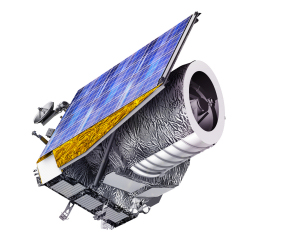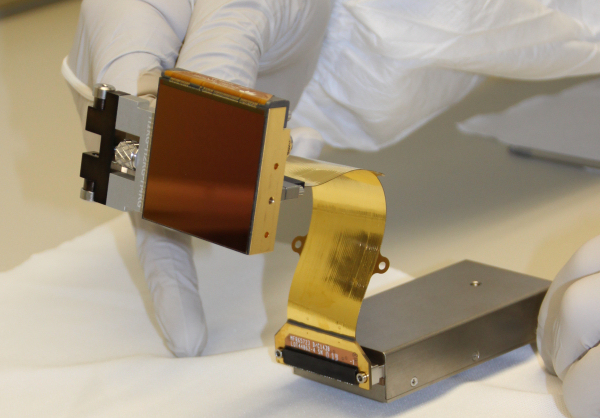Detector delivery marks another Euclid milestone
26 April 2017
ESA's Euclid mission has passed another important milestone with the delivery of the first three state-of-the art detectors for the Near-Infrared Spectrometer and Photometer instrument. |
| Artist's impression of Euclid. Credit: ESA |
Euclid is a pioneering mission to observe billions of faint galaxies and investigate the origin of the Universe's accelerating expansion, as well as the mysterious nature of dark energy, dark matter and gravity [1]. The space telescope will reveal the signatures of dark energy on the 3D distribution of cosmic structures.
In order to carry out this challenging mission, Euclid must survey the sky with very high precision at visible and near-infrared wavelengths. These measurements cannot be made from the ground, due to atmospheric absorption and turbulence.
To achieve its objectives, Euclid will carry two wide-field instruments: a Visible imager (VIS) and a Near-Infrared Spectrometer and Photometer (NISP). A dichroic plate [2] on the Euclid telescope enables incoming light to be shared by both instruments, so that the observations can be carried out in parallel through both channels.
The combined measurements by NISP and VIS will provide data on galaxy clustering and weak gravitational lensing in order to determine the distribution of dark matter and dark energy across the Universe.
"These detectors form the near-infrared 'retina' in Euclid's 'eye', the 1.2 metre diameter telescope and accompanying scientific instruments," says Rene Laureijs, ESA's project scientist for the Euclid mission.
One set of CCD detectors in the VIS instrument will map the Universe in visible light, but NISP's near-infrared detectors are sensitive to wavelengths invisible to the human eye, where very distant galaxies, 6-10 billion light years away, show their peak brightness.
"Euclid will unlock an unknown, near-infrared view of the sky by taking images of these galaxies over more than 36% of the celestial sphere with unprecedented sharpness," says Giuseppe Racca, ESA's Project Manager for Euclid.
With a structure made of silicon carbide, NISP is a very complex instrument designed to enable scientists to determine the photometric and spectroscopic redshifts of galaxies. The near-infrared photometric measurements will provide colour information for the galaxies imaged by VIS, while the spectroscopic redshift data will measure the velocities at which galaxies are moving away from us.
NISP is being developed under the responsibility of the Euclid Consortium, with CNES (the French space agency) and LAM / CPPM (Laboratoire d'Astrophysique de Marseille and the Centre de Physique de Particules de Marseille) as the main contributors. Other institutes and industries across Europe – in France, Italy, Germany, Spain, Norway, and Denmark – are also involved.
The NISP detectors were procured in the USA because such advanced devices were not available in Europe at the time. ESA started a Euclid-dedicated development programme with Teledyne Imaging Sensors of Camarillo, California, the leader in the manufacture of near-infrared detectors used in astronomy.
Following the successful qualification of a new type of detector, in a partnership with NASA, the flight models were designed, procured, and tested by NASA's Jet Propulsion Laboratory. They were then tested and characterised in the detector lab at NASA's Goddard Space Flight Center before being delivered to Europe.
 |
| A Euclid NISP detector. Credit: CPPM |
On 24 March, the first three HgCdTe (mercury cadmium telluride) near-infrared detectors for the NISP instrument, fitted with proximity electronics which are designed to operate at extremely cold, cryogenic temperatures, were delivered to LAM / CPPM in France.
When completed, the NISP instrument will include 16 of these detectors. Each of them is composed of 2040 × 2040 pixels, 18 microns in size.
The detectors will cover a field of view of 0.53 square degrees – slightly larger than twice the area covered by a full Moon. The photometric channel is equipped with 3 broad band filters (Y, J and H) covering the wavelength ranges 900-1192 nm, 1192-1544 nm and 1544-2000 nm. The spectroscopic channel is equipped with four different, low-resolution grisms – grating prisms that split incoming, near-infrared light into different wavelengths.
"Technically, NISP is a challenge," says Racca. "Onboard data processing is required to reduce the data stream generated by the 4 Megapixel detectors by a factor over 100, since it is impossible to deliver to the ground all the raw detector data. The spectrograph will provide redshifts for about 30 million galaxies during the 6-year prime mission.
"NISP passed its Critical Design Review in November 2016. This meant that the go-ahead for the construction of the NISP flight model was given. Delivery of the completed instrument is expected in the second half of 2018."
Meanwhile, following the delivery of the VIS detectors in January 2017, the arrival of the first NISP detectors is an important step in the development of the spacecraft's instrumentation.
In Euclid, as in other astronomy missions, the scientific instruments are the first flight hardware to be delivered because the spacecraft is assembled around them. Similarly the detectors are the first instrument hardware to be readied, as they are the first part of the "chain" to be characterised and assembled.
Every pixel of the NISP near-infrared detectors will now be thoroughly characterised at CPPM. They will then be assembled to form the NISP focal plane and finally integrated with the rest of the instrument for the instrument tests at LAM.
The NISP instrument will be delivered for integration into the Euclid payload module in the second half of next year.
Notes
[1] Within galaxies, stars and gas (made of "ordinary" or baryonic matter) are thought to be mixed with invisible dark (probably non-baryonic) matter, which dominates the total matter mass.
The nature of dark matter is unknown, although it may take the form of as-yet-undiscovered exotic particles falling outside the realm of the Standard Model of particles. Although dark matter has never been detected directly, its presence is inferred by measuring its gravitational influence on the rotation of galaxies and galaxy clusters. Dark matter is thought to account for about 27% of the matter in the Universe.
Dark energy is not a form of matter, but it is proposed as an explanation for the accelerating expansion of the Universe. It is believed to account for roughly 68% of the Universe, almost three times as much as dark matter. (In Albert Einstein's theory of relativity, matter and energy are equivalent concepts). Some scientists believe that dark energy is a property of "empty" space, but its real nature is a mystery.
[2] A dichroic plate is used to selectively filter light. For Euclid, the dichroic plate will split incoming light such that visible light is reflected to the VIS instrument while near-infrared light is transmitted to the NISP instrument.
Notes for editors
Euclid is an ESA medium class astronomy and astrophysics space mission. ESA selected Thales Alenia Space as prime contractor for the construction of the satellite and its Service Module, with Airbus Defence and Space chosen to develop the Payload Module, including the telescope.
The Euclid Consortium is a collaboration of nationally funded institutes responsible for the scientific mission, including the scientific instruments and data processing.
For further information please contact:
Giuseppe Racca
Euclid Project Manager
Directorate of Science
European Space Agency
Email: giuseppe.racca![]() esa.int
esa.int
René Laureijs
Euclid Project Scientist
Directorate of Science
European Space Agency
Email: Rene.Laureijs![]() esa.int
esa.int


